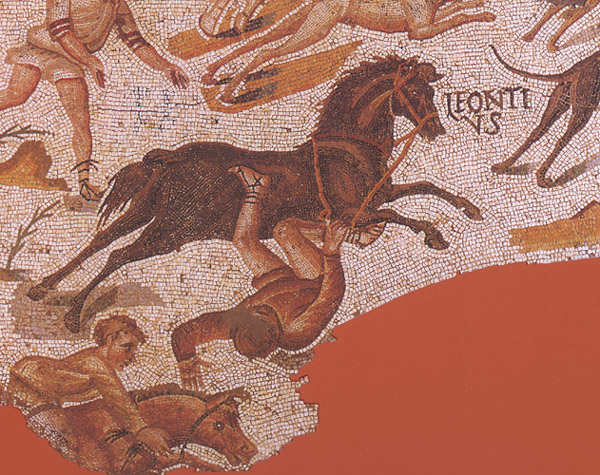

This third-century AD mosaic, which is in the Bardo Museum (Tunis), is part of a larger, fragmented scene depicting a hunting party on an estate in the Tunisian hills, where a horse named Leontius has thrown his rider. One can see the similarity to the Andalusian and Lusitano of the Iberian Peninsula (Arabian horses were unknown at the time). The horses of Numidia (Algeria) were renown, and the Romanized inhabitants of North Africa passionate about the hunt and the races, where another mosaic portrays a race horse and reads "Win or lose, we love you, Polidoxus."
It was Incitatus that was most coddled, who Caligula "used to invite to dinner, where he would offer him golden barley and drink his health in wine from golden goblets; he swore by the animal's life and fortune and even promised to appoint him consul, a promise that he would certainly have carried out if he had lived longer" (Dio, LIX.14.7). Suetonius relates that, on the day before the games, the emperor used to send soldiers into the neighborhood to order silence so that Incitatus would not be disturbed. "Besides a stall of marble, a manger of ivory, purple blankets and a collar of precious stones, he even gave this horse a house, a troop of slaves and furniture, for the more elegant entertainment of the guests invited in his name; and it is also said that he planned to make him consul" (LV.3).
Race horses were popular in their own right, apart from their association with a particular charioteer. Martial complains that, although he is well known to nations and to Rome, he is less famous than Andraemon, a horse of the celebrated Scorpus (X.9). Often, the lead horse of a biga or quadriga is mentioned by name when portrayed on a mosaic and depicted with palm branches stuck in the harness. Indeed, Vegetius, who is better known for a late fourth-century treatise on military science, wrote a veterinary tract entitled Mulomedicina, which was intended for the wealthy horse owner, for whom it was "glorious" to possess a noble and expensive animal.
The Christian apologist Tertullian, who was born in Carthage, where there was a circus, was not so enthusiastic about the races and writes in De Spectaculis (IX),
"Equestrian skill was a simple thing in the past, mere horseback riding; in any case there was no guilt in the ordinary use of the horse. But when the horse was brought into the games, it passed from being God's gift into the service of demons."
Aelian writes of the horses of Libya and, in criticizing their lack of care, provides some information as to what it should be.
"These Horses are exceedingly swift and know little or nothing of fatigue; they are slim and not well-fleshed but are fitted to endure the scanty attention paid to them by their masters. At any rate the masters devote no care to them: they neither rub them down nor roll them nor clean their hooves or comb their manes nor plait their forelocks nor wash them when tired, but as soon as they have completed the journey they intended they dismount and turn the Horses loose to graze."
On the Characteristics of Animals (III.2)
References: Mosaics of Roman Africa: Floor Mosaics from Tunesia (1996) by Michèle Blanchard-Lemée, Mongi Ennaïfer, Hédi Slim, and Latifa Slim; Aelian: On the Characteristics of Animals (1958) translated by A. F. Scholfield (Loeb Classical Library).